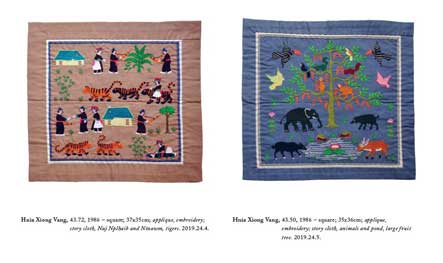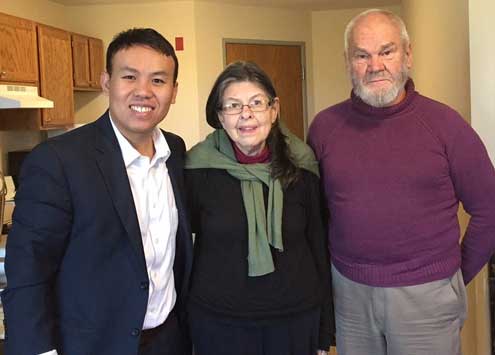When my mother, Porche Yang, died in 2011, I didn’t get the chance to record her paj ntaub story. I am glad that I got the opportunity to meet with Martha and put together this paj ntaub book from her collection for the Hmong community, and to remember my beloved mother and many amazing Hmong women who sew these pieces for the Hmong people and Hmong history.
I first became aware of Martha and her passionate collection of Hmoob paj ntaub tapestries and artifacts in 2016 and cannot begin to express my appreciation and gratefulness for her generosity in donating her entire collection to the Hmong Archives. Without her graciousness, this book would not have been possible. Her donation has enabled us to sustain the work and mission of Hmong Archives to research, collect, preserve, interpret, and disseminate materials in all formats about or by Hmong. All royalties and proceeds of this title will go to the Hmong Archives ensuring that Martha’s donation continues giving back to the Hmong community.
While Martha herself was not born into the Hmong community, she has been embraced by the many Hmong women she’s helped in selling their paj ntaub throughout the Midwest. Her thorough documentation of every artist, year, and type of paj ntaub sold ensured that the Hmong artists who created these beautiful works of art, were correctly attributed and received appropriate financial compensation for the works they sold. As deeply indebted to Martha as this book is, I would be remiss to not emphasize all of the work and artistry of the women who created these works of art themselves.
These women often received little to no formal education and instead supported their families and their dreams through their talent of putting needle to thread. They lived their lives making art and in turn, wove their narrative and the Hmong’s story into the larger fabric of America. Seeing their work was especially personal for me because they could’ve been my aunties, my sisters, or my mother. Like my mother, these women balanced their responsibilities as a mother and homemaker, and despite the demands of caring for a family in a new country, still somehow caught the last rays of sunshine to complete their paj ntaub. I still remember the sight of my own mother sitting on her green, bamboo, woven stool, sitting on the balcony of our two-bedroom apartment and repeating the same motions over and over again. Back then I found it tedious, but after her passing, the image of her sewing paj ntaub remains one of my most vivid memories. I hope that when members of the Hmong community page through the amazing works of art in this book, this familiarity resonates through them as well.
These intimate moments we share with paj ntaub itself, remain one of the driving forces in the publication of this title. I wanted to share, honor, and immortalize the many Hmong women whose works appear in this book. Oftentimes, they don’t receive enough credit where credit is due, and we hope this book presents these Hmong artists in a new light.
We are often familiar with seeing paj ntaub created and sold to individuals outside of the Hmong community. With the support of the Minnesota Humanities Center’s Legacy Cultural Heritage and Identity Micro-Grants, the Hmong Archives and Hmong Educational Resources Publisher hope this book was created to be accessible enough to the Hmong people to bring our art and craft back into the community. Although there is such an abundance of works to be displayed at the Hmong Archives, we believe that the best way to experience these pieces is to see them live in person.
As of September 30, 2020, Hmong Archives had accessioned some 221,000 items by and about Hmong, in 13 categories, from over 1,200 donors worldwide. Paj ntaub, or flower cloth, can refer to a female name, a Christian script, a music or fiction title, an event, or a periodical, so it is difficult to determine how many are paj ntaub textiles or contain information about this central element of Hmong culture. A full list of paj ntaub textiles and additional objects among the Hmong Archives’ complete collection can be found at the Hmong Archives website. To find more information on the operating hours of the Hmong Archives and to schedule a meeting, you can visit https://hmongarchives.org/
Ultimately, regardless of the context our readers bring into this book, we are proud that it was created by primarily Hmong hands first and foremost, for a primarily Hmong audience. Paj ntaub can be enjoyed by all, but there is extra cultural significance in seeing something from your history elevated with the care and respect our team committed.
Marlin Heise:
Perhaps a few lines about the processing of Martha’s paj ntaub and the birth of this book are of interest. We at Hmong Archives learned about the collection in 2016, then drove 21 boxes and bags home to St. Paul from Madison, WI, in June 2019, where the real work began. First step was to sort by types (squares, purses, belts, etc.), which became the book chapters. Next came sizes (small, medium, large), and then styles (cross-stitch, chainstitch, applique, etc.) before a final sort by artist names and numbers within these groups was done. Most items had pinned tags with this artist information, but some were missing after 30 years.
The 700 individual handwritten accession records were then typed to include the type, size, embroidery style, designs, colors, artist, artist’s number, year, and price. With three boxes of archival papers and books, this meant 71 pages for the 2019 Accessions record! A cotton twill tape with two felt tip lines for Accession Number and Artist’s Name/Number was stitched on the back (lower right corner for most pieces) with seven stitches – 4,900 stitches total! Exacting and tedious work for 700 beautiful paj ntaub to give each item a record.
Then began the more interesting project of creating the book. Brian shot twice the front and once the back of each paj ntaub (to get the accession number) while Marlin arranged and flipped them over on a table, or clipped them to stands. How many could be filmed in an hour? Next Brian (in cold Minnesota) selected and cropped photos while Marlin (in warm and sunny Cambodia) reduced those 71 pages of accession descriptions to 30 more manageable pages. Finally, the HER Publisher put the whole project together, designed by Fue Yang, and Martha L. Zimmerman Paj Ntaub Collection was born!
The book and paj ntaub are available for the public review at the Hmong Archives and East Side Freedom Library located at 1105 Greenbrier Street, St. Paul, MN 55106. To purchase your own personal copy, please visit the Hmong Educational Resources Publisher at www.herpublisher.com
























